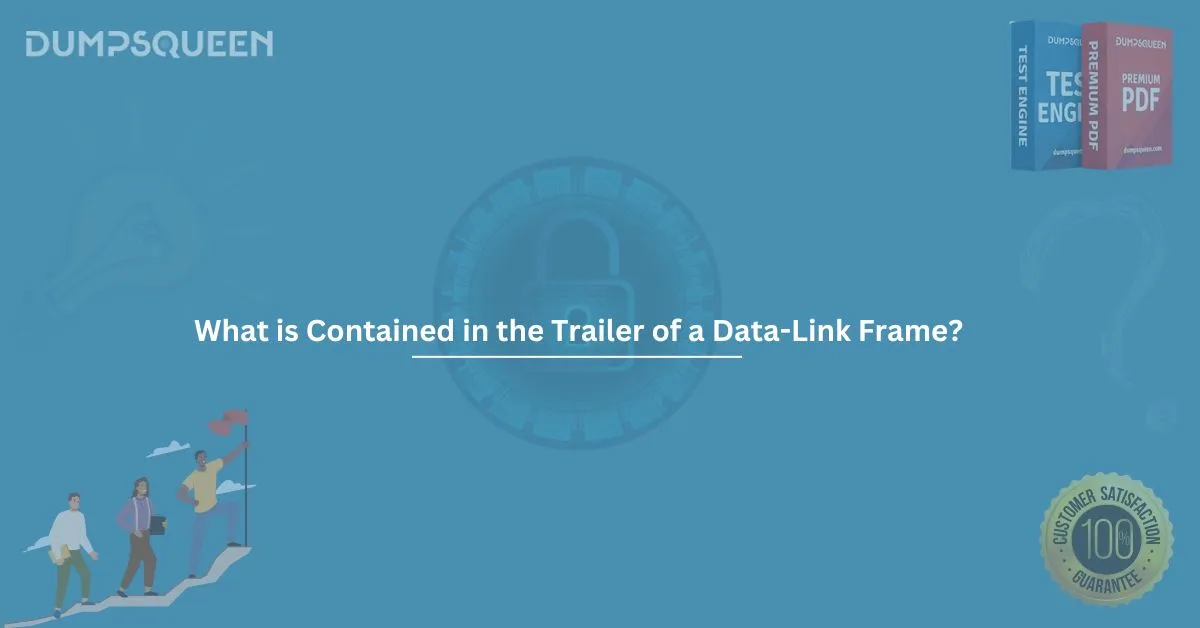When studying for networking certifications such as CompTIA Network+, Cisco CCNA, or other IT exams, understanding the structure of data-link layer frames is essential. One common question that arises is: what is contained in the trailer of a data-link frame? This seemingly simple question carries significant weight, especially when considering error detection, data integrity, and frame structure fundamentals.
In this detailed guide brought to you by DumpsQueen Official, we break down the trailer of a data-link frame, explain its purpose, provide real-world relevance, and offer sample MCQs to strengthen your exam preparation.
Understanding the Data-Link Layer in the OSI Model
Before diving into the specifics of the trailer, it’s crucial to understand the context. The Data-Link Layer (Layer 2) in the OSI (Open Systems Interconnection) model plays a key role in node-to-node data transfer. It ensures the reliable transmission of data frames between devices on the same network segment.
This layer is responsible for:
- Framing
- Addressing
- Error detection
- Flow control
- Media access control
A data-link frame is the protocol data unit (PDU) used at Layer 2. This frame consists of several components, one of which is the trailer.
Frame Structure: A Closer Look
Most data-link layer protocols—such as Ethernet, HDLC (High-Level Data Link Control), and PPP (Point-to-Point Protocol)—use a common structure for frames, which includes:
- Preamble
- Start Frame Delimiter (SFD)
- Header
- Payload (Data)
- Trailer
Let’s focus on the trailer, which is appended at the end of the frame.
What is Contained in the Trailer of a Data-Link Frame?
The trailer typically contains information used for error detection, ensuring the data has not been corrupted during transmission.
The main element found in the trailer is the:
✅ Frame Check Sequence (FCS)
The Frame Check Sequence is a type of cyclic redundancy check (CRC). This value is calculated based on the contents of the frame and is sent along with the data. When the frame reaches its destination, the same calculation is performed again. If the value matches the FCS in the trailer, the data is considered intact. If it does not match, it indicates that the frame has been corrupted during transmission and is usually discarded.
Functions of the Trailer in Data-Link Frames
The trailer serves several essential functions:
- Error Detection
- Uses CRC or checksums.
- Protects data integrity.
- Common in Ethernet and PPP.
- Frame Delimitation
- Helps define where the frame ends.
- Data Consistency Verification
- Ensures the payload hasn’t changed between source and destination.
- Efficient Troubleshooting
- Corrupted frames can be quickly identified and discarded.
Examples of Protocols Using Trailers
Let’s see how different protocols use trailers in real-world networking:
Ethernet
In Ethernet frames (IEEE 802.3), the trailer includes a 4-byte FCS field that uses CRC-32 to verify the integrity of the frame.
HDLC
The HDLC frame trailer also uses FCS for error detection, often 2 bytes long, depending on configuration.
PPP (Point-to-Point Protocol)
The trailer for a PPP frame contains a 2-byte FCS which performs a 16-bit CRC calculation.
Why is the Trailer So Important?
The trailer, although small in size, plays a crucial role in maintaining the integrity and reliability of network communication.
Here are some reasons it's indispensable:
- Minimizes Retransmissions: Only erroneous frames are retransmitted, improving network efficiency.
- Helps Diagnose Network Issues: Corrupted frame logs can guide troubleshooting efforts.
- Improves Data Reliability: Applications rely on Layer 2 error detection to deliver clean data to the upper layers.
How the FCS Works (Simplified Example)
Let’s consider a simple example of how FCS works in real-time:
- A device calculates a CRC value from the data payload.
- This value is placed in the FCS field of the trailer.
- Upon receiving, the destination device recalculates the CRC.
- If the value matches, the data is processed. If not, the frame is discarded.
It’s a statistical method, not foolproof, but extremely efficient in detecting most common errors.
Common Misconceptions
Let’s address some common misconceptions about trailers:
- ❌ The trailer contains routing information – False. Routing is handled at higher layers.
- ❌ The trailer ensures encryption – False. Encryption is handled at the presentation or application layers.
- ✅ The trailer checks data integrity – Correct.
Real-World Applications of the Trailer
The trailer is used in countless real-world applications. Here are a few:
- Enterprise Switches and Routers: Error detection before forwarding frames.
- Data Centers: High-throughput networks rely on CRC integrity checks.
- VoIP and Video Streaming: Minimizes corrupted data transmission, reducing latency and jitter.
- IoT Devices: Efficient frame validation in low-resource environments.
Troubleshooting with Trailers
Network administrators and engineers often use trailers to diagnose problems. Many network tools can inspect frames and reveal CRC mismatches or corrupted frames.
Example tools:
- Wireshark (packet analysis)
- Cisco IOS commands (show interfaces, etc.)
- SNMP-based monitoring
Errors detected via FCS mismatches are logged as "input errors" or "CRC errors" in device interfaces.
Summary Table
|
Feature |
Purpose |
Common Size |
|
Frame Check Sequence (FCS) |
Error detection using CRC |
2 to 4 bytes |
|
Trailer Location |
End of frame |
After data/payload |
|
Used In |
Ethernet, PPP, HDLC |
Common Layer 2 protocols |
Key Takeaways
- The trailer in a data-link frame mainly contains the Frame Check Sequence (FCS).
- It is used for error detection, not addressing or routing.
- Found in Ethernet, PPP, HDLC, and other Layer 2 protocols.
- Helps ensure data integrity and improves network reliability.
- Critical for exams like CCNA, Network+, and more.
Final Thoughts
Understanding what is contained in the trailer of a data-link frame is more than just passing an exam—it's about mastering the basics of reliable networking. Whether you're an IT student, network administrator, or preparing for certification, this knowledge forms a foundation for more advanced topics in routing, switching, and security.
For more in-depth resources, updated dumps, and reliable guides, explore DumpsQueen Official, your trusted platform for certification success.
Sample Multiple Choice Questions (MCQs)
Prepare for your exams using these realistic sample MCQs:
Q1. What is typically found in the trailer of a data-link frame?
A. Destination MAC Address
B. IP Header
C. Frame Check Sequence (FCS)
D. Source Port Number
Correct Answer: C. Frame Check Sequence (FCS)
Q2. What is the primary purpose of the trailer in a data-link frame?
A. Encryption
B. Compression
C. Error detection
D. Addressing
Correct Answer: C. Error detection
Q3. What does the Frame Check Sequence (FCS) detect?
A. Duplicate packets
B. Network congestion
C. Transmission errors
D. Protocol mismatches
Correct Answer: C. Transmission errors
Q4. Which of the following protocols use a trailer containing an FCS?
A. HTTP
B. DNS
C. Ethernet
D. TCP
Correct Answer: C. Ethernet




